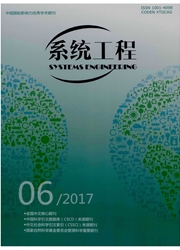

 中文摘要:
中文摘要:
利用偏好适应度(PF)模型和平均场(MF)理论,建立产学研合作创新网络多核型结构演化模型,并进行数值仿真研究。研究结果表明:偏好适应度择优机制能够有效抑制实力认知能力缺失和自我认知能力缺失对网络结构演化的干扰;产学研合作创新网络结构演化具有幂律衰减分布特性,且新节点涌入概率越小,网络平均节点度越大;随着网络演化阶段的递进,具有中心权利的核心节点越多且边缘节点关系越稠密,网络多核型结构越稳定;在连边次数较低的情况下,异质类网络平均节点度明显低于同质类网络平均节点度,而随着连边次数的增加,异质类网络平均节点度的增幅却明显高于同质类网络平均节点度。
 英文摘要:
英文摘要:
In this paper,we establish the evolution of I-U-R cooperative innovation network multi-karyotype structure(mechanism and Statistical Physics)model by using the preference fitness(PF)model and the mean field(MF)theory,and the numerical simulation.The results show that:the lack of the strength cognitive ability and self cognitive ability interfered with the evolution of I-U-R cooperative innovation network are restrained availably by preference fitness selection mechanism;evolution of I-U-R cooperative innovation network has the characteristics of power law decay distribution.And the probability of the new node into I-U-R cooperative innovation network is smaller,the average node degree of the network is larger;with the stages of network structure evolution is progressive,the number of center right core node is increasing and edge node relationship is more densely,network karyotype structure is more stable;while the number of edge is lower,the average node degree of heterogeneous network is obviously lower than the average node degree of homogeneous network,but with the increase of number of edges,an increase of heterogeneous network average node degree is obviously higher than that of homogeneous network average node degree.
 同期刊论文项目
同期刊论文项目
 同项目期刊论文
同项目期刊论文
 期刊信息
期刊信息
